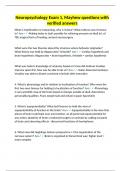Exam (elaborations)
Neuropsychology Exam 1, Mayhew questions with verified answers
- Course
- Institution
What is trephination or trepanning, why is it done? What cultures was it known in? Ans-Making holes in skull; possibly for relieving pressure on skull b/c of TBI; magical form of healing; ancient neurosurgery What were the two theories about the structure where behavior originates? What theory w...
[Show more]



